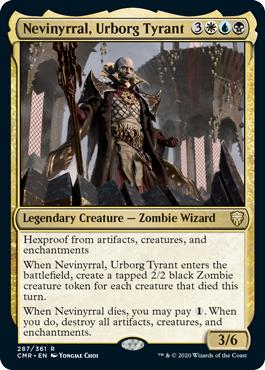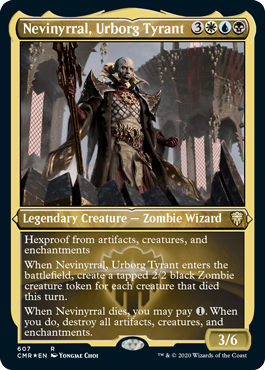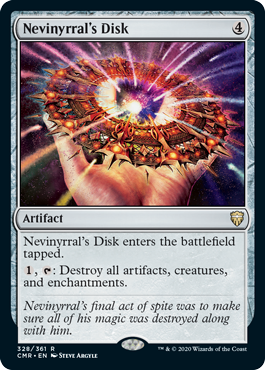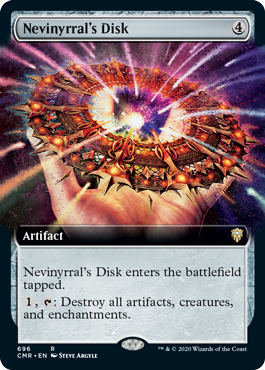Your Wish Is My Commander Legends, Part 2
Welcome to the second preview week of Commander Legends. Last week, I talked about the vision design of Commander Legends. This week, I'll be continuing my story with the set design of Commander Legends. Also, before I'm done, I'll have a couple preview cards to show you.
A quick aside before we begin today's story. When I started "Making Magic" eighteen years ago, there was a parallel column called "Latest Developments" that talked all about Magic development. I would introduce my design teams and the development teams in "Latest Developments." When we shifted over to the vision design, set design, and play design model, I started introducing the Vision Design teams, as those are the teams I oversee. It dawned on me as I was writing my first Commander Legends article that while I've continued to write bios for my Vision Design teams, the Set Design and Play Design teams haven't had the opportunity to be properly introduced, as there's no weekly column to do that, so starting with Commander Legends, I'm going to do a new thing where I ask the lead designer of each team to write up bios for their team. I'm going to hide them behind a click, so you can opt into reading them if you're interested.
That said, today's story is about the Commander Legends set design, so I've asked Jules Robins, the set lead designer to introduce himself and his team. (I'll be introducing the Commander Legends Play Design team in a future column.)
Meet the Legends Legends
Click below to meet the Commander Legends Set Design team.
Click to meet the Set Design team
Jules Robins

Before we were through drafting Pack 1 in Gavin's first proof-of-concept playtest for Commander Draft, I knew I wanted to work on this set. My two biggest loves in all of Magic are drafting and building Commander decks, and even before starting at Wizards of the Coast, I was working on a Commander cube. Fitting it all together turned out to be a lot harder than any of us anticipated, but thanks to many people's ceaseless work and dedication, we were able to sculpt something I'm proud of and that I hope you'll love. A special thanks to my Set Design teammates who went above and beyond hammering out problems with preposterous numbers of requirements and coming up with new approaches to tackle daunting tasks.
Hugo Anquier

Hugo came to Wizards for a 10-week summer internship, the same way I got my start at Wizards. As a designer who'd mostly worked on games outside of the TCG space, he brought a lot of ideas from fresh directions to the team and was especially adept at finding intriguing minigames for commanders to set up to give them unique playstyles.
Dave Humphreys

Dave is an extremely experienced and adept set design lead, most recently leading Dominaria, War of the Spark, and Ikoria: Lair of Behemoths. He brought invaluable perspective to things both small and large: from tiny card tweaks that avoided unsatisfying interactions to identifying when play patterns were taking up too much of the aggregate focus of the games. On top of that, he's built up a sharp sense of which cards will capture players' imaginations to help us home in on the rough designs in need of extra polishing.
Brandon Kreines

This was Brandon's first time on a design team (he was a business systems administrator at the time), and he impressed everyone so much that a couple years later, he became game producer for our whole mechanical game design and editing process! In addition to generating a steady stream of new card ideas, Brandon came up with improvements to our process to tackle this momentous undertaking, like creating a framework and rating system so we could figure out how well various partners paired up.
Ken Nagle

Ken's a longtime designer with a penchant for churning out card ideas and approaching problems from perspectives unlike anyone else's. That proved especially important for figuring out the details of the draft portion. When we were grappling with the drafts taking too long, the last picks of each pack getting boring, and cards coming all the way back around the table too consistently, he realized we could solve all our problems by picking two cards at a time.
Adam Prosak

I learned a lot about leading booster sets from working alongside Adam as he lead Modern Horizons, and he continued to offer expertise and insight with the roles reversed. Adam brought attention and nuance to questions ranging from how to distribute our Limited themes and mesh them together to what Limited balance even means to an environment where your commander(s) change the efficacy of every card and multiplayer dynamics might not favor the player who looks ahead.
Paul Cheon

Paul served as our play design representative for much of set design (though he's since moved on to work on the esports team). He brought along a lot of best practices, like balancing our regular Draft environments and, together with Adam, tackling the difficult questions of which we could or should adapt to multiplayer Commander Limited. This was especially important to power-banding the uncommon legends so the same cards could serve as fun options for both Constructed Commander and Limited games.
Sam Stoddard

Sam's renowned for cranking out whole files' worth of new cards in short order; I think he rebuilt the Ravnica Allegiance file from the ground up at least twice over, and he brought that same rapid-fire idea generation to this team. It wasn't rare to walk into a meeting with a list of cards that weren't working and walk out with a half-dozen new designs from Sam that became cornerstones of the set.
Ready, Set. . . Design
Our story begins with Jules Robins and his Set Design team getting the handoff from Gavin Verhey and his Vision Design team. Here's what was handed off:
- A set size (361 cards) with some number of new cards (the end product had 165)
- Four mechanics (advocate, cascade, monarch, and partner)
- Draft rules (60-card decks, duplicates allowed, The Prismatic Piper, etc.)
- Two possible booster pack sizes (15- and 20-card packs—the one selected would impact how the set would draft)
- Leaning into nostalgia as a theme
- The philosophy of "Commander Limited can be different, but only in how decks are built; the gameplay should match Commander Constructed."
Gavin and his team had done a lot to define the larger vision of the set, but there were significant execution issues to be resolved. To use my frequent house-building metaphor, the Vision Design team created a very ambitious blueprint for an amazing house and the Set Design team had to figure out how to actually build it.
The two biggest challenges were:
- How would we build the set such that it had all the cool parts of Draft while maintaining the essence of Commander?
- How would we make the draft short enough that it was a fun Draft experience?
These two challenges, while distinct, were very intertwined. The second problem had the easier solution, so I'm going to start with that one.
How would we make the draft short enough that it was a fun Draft experience?
Jules and his Set Design team agreed with the Vision Design team's recommendation of drafting 60 cards to build a 60-card deck. It was the right balance between not drafting too many cards and having enough cards to let players have some options in how to build their deck. This meant that the draft was going to be either four 15-card booster packs or three 20-card booster packs.
The 20-card booster packs won out for two main reasons. One, drafting three packs just takes less time than drafting four, partly because you're doing more drafting of packs you've already seen and partly because the logistics of starting a new pack tends to slow things down as everyone waits for the group to finish drafting the current booster before starting on the new one. Two, Jules and his team were finding that one legendary creature per booster wasn't enough to give people enough choices early in the draft and a shift to 20-card boosters made it easier to add in the second legendary creature.
Even shifting to 60-card decks and 20-card boosters wasn't speeding up the draft enough, however. The goal had been to make it take only slightly longer than a normal booster draft, and 60 cards was taking a third longer than drafting 45 cards. That's when Ken Nagle made an interesting a suggestion. (Those of you that read the bios above know where this is going.) What if instead of drafting one card you drafted two for each pick? This would allow you a little more ability to shape your draft early on and dropped the "pick stops" from 60 to 30. Yes, picking two cards took more time than picking one, but far less than picking two cards at different times. That one decision got the drafts into the ballpark of the needed time frame.
How would we build the set such that it had all the cool parts of Draft while maintaining the essence of Commander?
Now comes the more demanding challenge. The solution to this problem was realizing that it was actually the combination of numerous smaller problems. Fix the smaller problems in aggregate, and you solve the larger problem. Let's walk through a number of the small problems and their fixes:
- How to use new cards and reprints
Vision Design had taken a page from sets like Battlebond and used its reprints to reprint big splashy cards, including a lot of popular legendary creatures. They then used the new cards to create lower rarity cards to try and make the various themes of the reprinted legendary creatures work in Draft. This was causing all sorts of issues because the themes were not synergistic with one another. What Set Design discovered was that they needed to use the new cards to make the legendary creatures and splashy rares and use the reprints at lower rarities to reprint cards that helped make those themes work together. Using the new cards to define the themes was key to making the Draft archetypes work.
- Increasing legendary creatures per pack
Another problem Set Design discovered was that having only one legendary creature per booster forced players to follow what was available rather than give them agency to try and make an interesting deck. By adding an additional legendary creature, it allowed all the drafters more flexibility, which led to a more dynamic draft. I should also note that they ended up adding a guaranteed foil to each pack and that its slot would also occasionally have yet another legendary creature, providing additional options. (More on this below.)
- Changing one of the mechanics
Partner was doing a great job of giving players the ability to shift into additional colors in the draft. Cascade was adding some casual friendly variance. Monarch was encouraging attacking, which is always a good thing in multiplayer as it helps to end the game. Advocate (a new mechanic that triggered when you played your commander or attacked with it) was causing some problems. It was encouraging certain strategies (such as playing commanders that were cheaper or ones that could attack safely) that were leading to poorer gameplay. Meanwhile, it was clear that the set was lacking some kind of mana sink (something to let players spend their extra mana on, especially in the late game). The solution to this problem was to replace advocate with encore. Encore is a new mechanic that's a cross between unearth and myriad. Here's the reminder text:
(<mana cost>, Exile this card from your graveyard: For each opponent, create a token copy that attacks that opponent this turn if able. They gain haste. Sacrifice them at the beginning of the next end step. Activate only as a sorcery.
Encore also helped bridge a lot of themes to supplement various drafting archetypes. For example, it helps blue-black's graveyard theme, white-black's token theme, black-red's sacrifice theme, and black-green and blue-red's tribal themes.
- Increasing the number of commons
Set Design made another shift around the rarities to allow commons to have a higher percentage of cards than normal. This helped fit in more themes while lessening the times that players played duplicates of cards to help make Limited feel more Commander-y.
- Looking at partner synergies
It turns out that between all the cards with partner in this set (including reprints of all the older legendary creatures with partner—more on this below), there are over 1,500 different partner combinations. Jules and his team spent a bunch of time trying to identify as many synergies as they could between partners.
- Upping the as-fan of legendary creatures
Vision Design turned over the set with a lot of legendary creatures in it, but Set Design realized that they could up the as-fan in three ways. One, they added some to the set. Commander Legends has 69 legendary creatures (plus two legendary planeswalkers that can be your commander), more than any other set ever printed. Two, they moved more legendary creatures down to uncommon. (Of the 69 legendary creatures in the set, 40 are uncommon.) Three, part of Booster Fun added in some legendary creature reprints (more on this below).
- Increasing the amount of colorless cards
The other big problem to solve was how to avoid the silo issue where players make commitments early (on commander color identity) and then everyone keeps drafting the same deck they did the last time they played that theme. Partner helped some, but the other big shift in set design was the adding of a lot more colorless cards that could be picked up by any deck regardless of color identity
All these smaller fixes led to fixing the larger drafting problem.
Booster Fun
Another aspect of this story that I haven't gotten into was the timetable of how long this all took. Commander Legends proved to be a bit more complex than anyone expected, getting pushed back in the schedule numerous times to give the team more time to work on it. From Gavin's first playtest to it seeing print was almost six years (which I believe makes it the second longest after Unstable's seven years). It's because of this moving around that Commander Legends doesn't have Set Boosters. They didn't exist when design started on the set, and by the time we realized it was coming out after Set Boosters were being introduced, it was too late to add them. Luckily, the same was not true for Booster Fun (R&D's name for the cards with alternate frames, art, and/or treatments—read here for more).
First up, the Commander Legends team knew that Commander players like to bling out their decks, so a dedicated foil slot was added to every booster. This foil slot can have any card from the set, including legendary creatures, which means some booster packs with have three legendary creatures in them (as every booster pack has two non-foil legendary creature slots). Then they added a new type of foiling called foil etched. It's hard for me to describe it, but Gavin posted a video of one so you could all see it. It looks pretty cool. Every legendary creature in the set has a foil-etched version. The foil-etched cards appear in the foil slot, replacing the normal foil when they appear. In addition, there are 32 legendary creature reprints (including all the original creatures with partner) that also appear (and only appear) in foil etched. In addition to that, both planeswalkers have a borderless planeswalker version and many of the cards have an extended-art version. The borderless planeswalkers do appear in Draft Boosters, but the extended-art cards are only found in the Collector Boosters.
Room with a Preview
That, in two weeks of columns, is the story of Commander Legends's design. Before I sign off for today, however, I do have two preview cards to show you. One of them is a famous character first referenced in Alpha that has never gotten a card before. The card that references this character is a reprint in the set and is a staple in many Commander games. Can you guess the names of my two preview cards?
Click below to see if you're correct.
Click to show two CMR preview cards




Gavin and Kelly had tagged Nevinyrral as a perfect candidate for a legendary creature card. Nevinyrral's Disk is a famous card from Magic's beginning and seemed only appropriate in a set all about famous characters to finally give him a card. The early Nevinyrral was white-black (at the time, the set only had monocolor and two-color legendary creatures), but when Set Design added in three-color creatures, blue was added to Nevinyrral. The key to his design was to make a card that synergized with Nevinyrral's Disk. I hope you all have fun giving him a try.
That's it for today. I hope you enjoyed my peek into the design of Commander Legends. If you have any thoughts on these last two columns or on the set in general, please feel free to email or contact me through any of my social media accounts (Twitter, Tumblr, Instagram, and TikTok).
Join me next week when I take a look at the history of some of Commander Legends's new legendary creatures.
Until then, may you draft the most awesome Commander deck.
#787: Henry Stern
#787: Henry Stern
30:45
In this podcast, I interview Henry Stern, a longtime member of R&D and former pro player.
#788: 25 Years
#788: 25 Years
32:06
October 30, 2020 was my 25th anniversary of working at Wizards. In this podcast, I talk about the many things I've done in those 25 years.
- Episode 786 Oozes
- Episode 785 Scott Larabee
- Episode 784 It's All Magic

